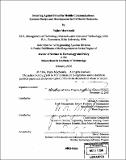Securing against fraud in mobile communications : system design and development in 3G mobile networks
Author(s)
Mochizuki, Yujiro, 1973-
DownloadFull printable version (6.585Mb)
Other Contributors
Massachusetts Institute of Technology. Technology and Policy Program.
Advisor
Michael A. Cusumano.
Terms of use
Metadata
Show full item recordAbstract
Network security ensures the consistency, integrity, and reliability of telecommunications systems. Authorized network access prevents fraudulent communications and maintains the availability of the systems. However, limited development time, cost reduction pressure and requirement for high reliability in software development have forced mobile carriers to implement the insufficient and inflexible authentication mechanisms. Technical specifications including network architecture, network protocols, and security algorithm are widely available to the public. In addition, both secured and unsecured networks are interconnected by global roaming services. The inadequate system design will make the mobile systems vulnerable to unauthorized access to mobile communications. Compared with GSM mobile systems, 3G mobile systems are equipped with more robust and flexible security mechanisms. The official position taken by mobile carriers, such as NTT DoCoMo, KDDI, and Vodafone, is that fraudulent communications, usually in the form of cloned mobile phones, are impossible with their 3G mobile systems. Examining the NTT DoCoMo's case, however, we find that this statement is based on weak security assumptions. (cont.) In order to avoid potential threats and to secure the 3G mobile systems, this thesis (1) explores the security architecture and mechanisms in 3G systems, (2) analyzes the current platform architecture and platform innovations of the network software, and (3) suggests a secure system design and development.
Description
Thesis (S.M.)--Massachusetts Institute of Technology, Engineering Systems Division, Technology and Policy Program, 2006. Includes bibliographical references (leaves 120-124).
Date issued
2006Department
Massachusetts Institute of Technology. Engineering Systems Division; Technology and Policy ProgramPublisher
Massachusetts Institute of Technology
Keywords
Technology and Policy Program.